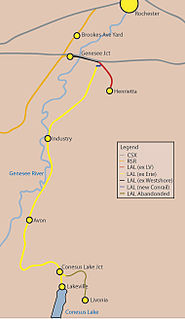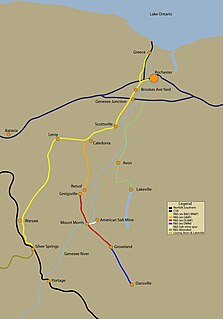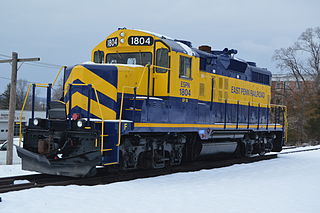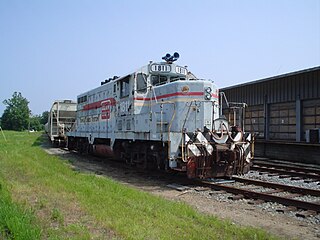Related Research Articles

The Norfolk Southern Railway is a Class I freight railroad in the United States, formed in 1982 by the merger of the Norfolk and Western Railway and the Southern Railway. With headquarters in Atlanta, Georgia, the company operates 19,420 route miles in 22 eastern states, the District of Columbia, and has rights in Canada over the Albany to Montréal route of the Canadian Pacific Railway, and previously on CN from Buffalo to St. Thomas. NS is responsible for maintaining 28,400 miles (45,700 km), with the remainder being operated under trackage rights from other parties responsible for maintenance. Intermodal containers and trailers are the most common commodity type carried by NS, which have grown as coal business has declined throughout the 21st century; coal was formerly the largest source of traffic. The railway offers the largest intermodal rail network in eastern North America. NS was also the pioneer of Roadrailer service. Norfolk Southern and its chief competitor, CSX Transportation, have a duopoly on the transcontinental freight rail lines in the Eastern United States.

Conrail, formally the Consolidated Rail Corporation, was the primary Class I railroad in the Northeastern United States between 1976 and 1999. The trade name Conrail is a portmanteau based on the company's legal name. It continues to do business as an asset management and network services provider in three Shared Assets Areas that were excluded from the division of its operations during its acquisition by CSX Corporation and the Norfolk Southern Railway.

The Livonia, Avon and Lakeville Railroad is a short line railroad that operates in Livingston County and Monroe County in New York, United States. The railroad interchanges with CSX at Genesee Junction in Chili, New York, the Rochester and Southern Railroad (RSR) at Genesee Junction and the RSR's Brooks Avenue Yard in Gates, New York, and with the Rochester & Genesee Valley Railroad Museum at Industry, New York. Their primary freight consists of food products - grains and corn syrup. In 1997, the Livonia, Avon and Lakeville Railroad was selected as Short Line Railroad of the Year by industry trade journal Railway Age. The LAL is also the parent company for both the Bath and Hammondsport Railroad and Western New York and Pennsylvania Railroad.
The Lancaster and Chester Railroad or L&C is a railway headquartered in Lancaster, South Carolina. The original 29-mile (47 km) route connects Lancaster in Lancaster County with Chester in Chester County. The line's nickname is The Springmaid Line, which refers to its original purpose of connecting the plants of the Springs Mills company.

The Alabama and Tennessee River Railway is a shortline railway operating over trackage formerly operated by CSX Transportation. The line's western terminus is a junction with the CSX main line in Birmingham, Alabama, near CSX's Boyles Yard. The eastern terminus is Guntersville, Alabama, near the Tennessee River. The parent company of the ATN is OmniTRAX, a major operator of American and Canadian short lines.

The Georgia Southwestern Railroad is a Class III short line railroad company that operates over 234 miles (377 km) of track in southwestern Georgia and southeastern Alabama. Beginning in 1989 as a division of the South Carolina Central Railroad on a pair of former CSX Transportation lines, the railroad has since undergone a number of transformations through abandonments and acquisitions, before arriving at its current form. The railroad was formerly a RailAmerica property before going independent, and in 2008 it was acquired by Genesee & Wyoming Inc.

The Norfolk and Portsmouth Belt Line Railroad is a class III railroad operating in southern Virginia.

The Willamette Valley Railway is a short-line railroad that operates in the Willamette Valley of Oregon. It leased a line from Woodburn to Stayton from the Southern Pacific Transportation Company in February 1993, as well as a branch from Geer west to Salem, and purchased the property in 1996. The company also leased a line between Albany and Mill City in 1993, but transferred the lease to the Albany and Eastern Railroad in October 2000.

The Wiregrass Central Railroad is a shortline railroad operating 19.5 miles (31.4 km) of track from a CSX Transportation connection at Waterford, near Newton, to Enterprise, Alabama via the south side of Fort Rucker. The company was initially a subsidiary of Gulf and Ohio Railways and began operations in 1987 following the purchase of the Enterprise Subdivision branch line of CSX Transportation.

The Rochester and Southern Railroad, a subsidiary of Genesee & Wyoming Inc., is a class III shortline that runs from the city of Rochester in Monroe County to Silver Springs, NY. The RSR started in 1986, when the B&O sold off its Buffalo and Rochester branches. The trackage was purchased by Genesee & Wyoming Inc., and split into two railroads, the Buffalo and Pittsburgh Railroad and the Rochester and Southern Railroad. The Rochester branch was scrapped from Silver Springs south to Machias, New York.
Pickens Railway is a shortline railroad that has operated on two separate divisions in the Upstate Region of South Carolina:
The Pine Belt Southern Railroad was a shortline railroad formerly operating on two disconnected track segments in east central Alabama. Upon its start in 1995 the railroad ran over a branch from Nuckols to Hurtsboro, Alabama. In 1996 a second branch was acquired, extending from Roanoke, Jct., near Opelika, to Lafayette, Alabama. Together the lines totaled 42.4 miles (68.2 km) and the railroad was controlled by Richard Abernathy.

The East Penn Railroad is a short-line railroad that operates a number of mostly-unconnected lines in the U.S. states of Pennsylvania and Delaware. Except for two industrial park switching operations, all are former Pennsylvania Railroad or Reading Company lines, abandoned or sold by Conrail or its predecessors.
The West Tennessee Railroad is a shortline railroad in the Southern U.S., connecting Corinth, Mississippi, to Fulton, Kentucky, via western Tennessee. The company began operating in 1984 on a portion of the former Mobile and Ohio Railroad (M&O) main line between Jackson and Kenton, Tennessee. It significantly expanded operations in 2001 through the lease, from the Norfolk Southern Railway, of the ex-M&O south to Corinth and a former main line of the Illinois Central Railroad (IC) north to Fulton, as well as a branch from Jackson to Poplar Corner. All of these lines were part of the Illinois Central Gulf Railroad (ICG) prior to its 1980s program of spin-offs, during which Gibson County purchased the Jackson-Kenton line and the Southern Railway acquired the Corinth-Fulton line and Poplar Corner branch.
The following is a brief history of the North American rail system, mainly through major changes to Class I railroads, the largest class by operating revenue.

Lake State Railway is a railroad operating in the Saginaw Valley and northeastern quadrant of the Lower Peninsula of Michigan. The railroad moves large quantities of aggregate and limestone, as well as coal, grain, and chemical products. Some of the company's largest customers include Dow Chemical Company, S. C. Johnson & Son, Lafarge, ConAgra Foods, Archer Daniels Midland, Conrad Yelvington Distributors, and Consumers Energy.
The Georgia Great Southern Railroad was a shortline railroad formerly operating between Dawson and Albany, Georgia, 24.2 miles (38.9 km). The railroad was partially abandoned in 1994. RailTex consolidated its holdings in the area into the Georgia Southwestern in 1995, and the Georgia Great Southern ceased to exist as a separate railroad.

The Wabash Railroad was a Class I railroad that operated in the mid-central United States. It served a large area, including track in the states of Ohio, Indiana, Illinois, Iowa, Michigan, and Missouri and the province of Ontario. Its primary connections included Chicago, Illinois; Kansas City, Missouri; Detroit, Michigan; Buffalo, New York; St. Louis, Missouri; and Toledo, Ohio.

The Grenada Railroad is a 180-mile long (290 km) shortline railroad that runs from Southaven, Mississippi to Canton, Mississippi, along former Illinois Central Railroad trackage. GRYR interchanges at Jackson, Mississippi, with the Canadian National, and at Memphis, Tennessee with CN, Norfolk Southern, Union Pacific, and CSX. The main commodities the Class III railroad hauls include chemicals, flour, lumber, paper, plastics, and petroleum. The Grenada Railroad is operated by RailUSA.

The Caldwell County Railroad is a Class III shortline railroad operating over 17 miles between Hickory and Lenoir, North Carolina. The CWCY is operated by Southeast Shortlines, Inc., which also operates the Thermal Belt Railway.
References
- ↑ Lewis, Edward A. (1991). "Thermal Belt Railway". American Shortline Railway Guide. p. 257.
- 1 2 3 Wrinn, Jim (June 1991). "Warming Up To The Thermal Belt". Railfan & Railroad: 64–67.
- ↑ Surface Transportation Board (February 2, 2001), STB Docket No. AB-567, (Sub-No. 1X)
- ↑ , "Freight Rail & Rail Crossing Safety Improvement Fund Projects" (retrieved 7/7/2014)
- ↑ Don Ross (6 July 2021). "Paducah Rebuilt Electro-Motive GP Diesels 8300-8397" . Retrieved 21 July 2022.
- ↑ "Pictures of TBRY 4601" . Retrieved 21 July 2022.